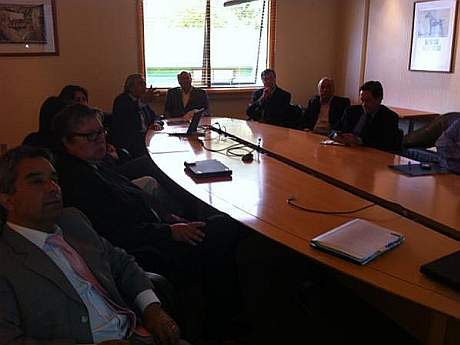The day before Christmas, Joe Nocera did it again—wasted a perfectly good column with another attack on us, Peter Wallison and Ed Pinto.
It's worth reading for what it says about the Left's current situation. According to Nocera, we "almost single-handedly" have created a "myth that Fannie Mae and Freddie Mac caused the financial crisis." Those who have fallen for this myth, according to Nocera, include congressional Republicans and the Wall Street Journal's editorial page.
It's somewhat implausible that two guys at a Washington think-tank, arguing that the financial crisis was caused by government housing policy, could create a widely accepted alternative to the conventional liberal narrative that the financial crisis was caused by the greed and lack of regulation of Wall Street. After all, the conventional narrative was created by the government, propagated by the New York Times, and accepted without question by just about every other major newspaper and electronic mass media outlet, foreign and domestic. Apparently, however, in Noceraworld, threats to the accepted narrative can never be fully suppressed.
It's somewhat implausible that two guys at a Washington think-tank could create a widely accepted alternative to the conventional liberal narrative that the financial crisis was caused by the greed and lack of regulation of Wall Street.
We doubt that we have been as successful as Nocera fears, but we believe that Nocera and his ilk are losing the argument about what caused the financial crisis. If in fact our views have received sufficient credence to warrant the alarm of the New York Times, a reading of his attack piece will tell you why. The article is fully representative of the Left's approach—don't bother with facts, just call your opposition liars or worse (racists) and leave it at that. This name-calling is then dutifully repeated throughout the leftwing echo-chamber.
To the extent that we have had any success in challenging the conventional narrative about the causes of the crisis, it is because fair-minded people are persuaded by facts, not invective. Our argument is and has been that the financial crisis would not have occurred but for government housing policy implemented principally through Fannie and Freddie and the Department of Housing and Urban Development (HUD). Although there were a number of such policies, the most important were the affordable housing requirements first imposed on Fannie and Freddie in 1992 and expanded and tightened by HUD through 2007.
Summarized below are the original numbers we relied on, taken from Fannie and Freddie's own data and from the views of bank regulators—and now supplemented with additional data from the Securities and Exchange Commission's recent complaints against certain officers of Fannie and Freddie. Of particular interest are Fannie and Freddie's non-prosecution agreements with the SEC, in which they agree with facts that confirm—and in many cases go beyond—our original research concerning the scope of the GSEs' subprime and Alt-A exposure. These are facts, and Nocera and others who might wish it otherwise should become familiar with them.
For example, in its non-prosecution agreement Freddie agreed that as of June 30, 2008, it had $244 billion in subprime loans, comprising 14 percent of its credit guaranty portfolio, rather than the $6 billion it had previously disclosed. Freddie also agreed that it had $541 billion in reduced documentation loans alone, vastly more than the $190 billion in previously disclosed Alt-A loans which Freddie had said included loans with reduced documentation.
While the SEC documents about $1.03 trillion in previously undisclosed subprime and Alt-A loans in Fannie and Freddie's credit guaranty portfolios, an estimated $812.8 billion, or about 80 percent, were already accounted for in the totals of Fannie and Freddie subprime and Alt-A exposures included in Pinto's Forensic Study and Wallison's Dissent from the majority report of the Financial Crisis Inquiry Commission.
The SEC findings add $219 billion and 1.43 million loans to our original Fannie and Freddie subprime and Alt-A totals, bringing the combined subprime and Alt-A total to $2.041 trillion and 13.37 million loans.
The SEC findings add $219 billion and 1.43 million loans to our original Fannie and Freddie subprime and Alt-A totals, bringing the combined subprime and Alt-A total to $2.041 trillion and 13.37 million loans.
All told, after adding the SEC's new data to our original estimates, there were approximately 28 million subprime and Alt-A loans outstanding on June 30, 2008, before the financial crisis, with a value of approximately $4.8 trillion. This was half of all mortgages in the United States. Of these loans, over 74 percent were on the books of U.S. government agencies and firms subject to government housing finance policies. This shows where the demand for these low quality loans came from. Fannie and Freddie were themselves exposed to more than 13 million subprime or Alt-A loans, or 65 percent of the government total.
The table below shows the values of the subprime and Alt-A loans originally included in Pinto's Forensic Study and Wallison's Dissent, supplemented by the data included in the SEC's complaints and the non-prosecution agreements.
Fannie and Freddie subprime and Alt-A totals as of June 30, 2008
(All numbers de-duped to eliminate inclusion in more than one category.)
Table in billions of dollars

Peter J. Wallison is the Arthur F. Burns Fellow in Financial Policy Studies and Edward Pinto is a resident fellow at the American Enterprise Institute.
Footnotes
1 In 2001, federal regulators determined that a FICO score of less than 660 can be used to identify a subprime mortgage. http://www.federalreserve.gov/Boarddocs/SRletters/2001/sr0104a1.pdf
2 The GSEs published credit supplements at the time of their SEC filings. These supplements set forth loan characteristics with high risk. These included negative amortization, interest pnly, original LTV>90% (effectively >=95%), and Alt-A as disclosed by Fannie and Freddie.
3 In the case of both original LTV>90% and combined LTV>90%, the effective LTV is >=95%. In the case of original LTV>90%, this is confirmed by the fact that the LTV average for such loans was 97.4%. In the case of combined LTV, the 80/20 and 80/15 combinations would have resulted in a combined LTV>=95%.
4 These differ slightly from the Forensic Study/Dissent subtotals due to rounding and the need to change the de-duping hierarchy to incorporate the SEC additions.
5 $101.7 billion prior to de-duping.
6 $238 billion prior to de-duping.
7 $341 billion prior to de-duping.
8 $351 billion prior to de-duping.
Image by Bergman Group




